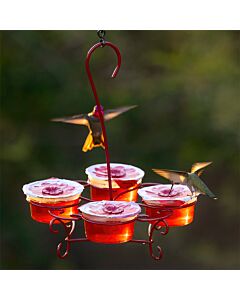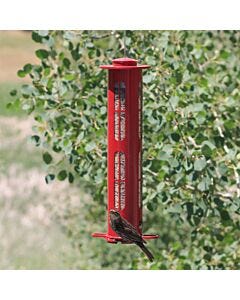BLUEBIRD
BIRD LIBRARY »
Appearance of the Bluebird
Although considered a medium-size songbird, Bluebirds are relatively small for a member of the Thrush family. They are typically no more than 8 inches in length and weigh one ounce on average, which is about 2/3 the size of another popular Thrush, the American Robin.
These beautiful birds stand out because of their stunning plumage. Of the three species of Bluebirds in North America, Eastern Bluebirds are the most widely recognized. Males are relatively easy to distinguish between each species because of the varying shades of blue. However, females from species to species can be more difficult to identify due to their similar color palette.
Eastern Bluebird
Male Eastern Bluebirds have a rich blue head and back, which contrasts beautifully against the white and rust-colored feathers on their throat and breast. From a distance, the striking blue color can often appear to be pale gray-brown.
Females, on the other hand, have more subdued coloring than males of the species. Their head and back are a grayish color, while only their wings and tail feature the Bluebird’s signature elegant blue shades. Their breast and throat are light orange-brown. Eastern Bluebirds usually have a plump body with a large rounded head and big eyes. They have long wings but shorter tail and legs. The bill is also short and fairly straight.
Western Bluebird
Western Bluebirds have a very similar appearance to their eastern cousins. However, for males, the blue plumage is usually a deeper shade of shiny blue. In addition, their rusty orange breast extends onto the upper back above the wings, while the lower belly is a white color. Unlike Eastern Bluebirds, their throat is also blue. This bright coloring is noticeably absent from female Western Bluebirds, which feature a dominantly grayish-tan color. Some tinges of blue can be found on their wings and tales. Rather than a bright rusty tint, females have a pale orange breast.
This western species is relatively close in size and shape to the Eastern Bluebird. These birds have a pleasantly plump build paired with a somewhat short tail. Their bills are straight and slender.
Mountain Bluebird
The most distinct of the three North American species is the Mountain Bluebird. Unlike their cousins, the Mountain Bluebird is recognizable by a subtle pastel color palette. Male Mountain Bluebirds are predominantly sky blue, rather than dark, rich blue. However, they do have some darker blue patches on their wings and tail. The breast area is much paler, while underneath the tail is white. Occasionally you will see Mountain Bluebirds with orange tints on their breast. Like the other bluebird species, females have a paler gray-brown color with some patches of blue on the wings and tail.
This species is much more slender and lanky than their eastern and western counterparts. Mountain Bluebirds have both long wings and a long tail. Although, they do have similarly round heads paired with straight, slender bills (which are longer and completely black).
Geography of the Bluebird
Between the three species, Bluebirds can be spotted all across North America. Eastern Bluebirds have the widest range, covering the eastern half of the United States as far west as Colorado. They extend as far north as southern Canada, and as far south as Nicaragua.
Western Bluebirds have a much smaller range and can be found – you guessed it – in the western region of the United States and Mexico, west of the Rocky Mountains. Their breeding range extends north into the southwestern portion of Canada. Mountain Bluebirds occupy the same general region as Western Bluebirds, however, they nest at higher elevations as their name suggests.
Bluebirds are considered partial migrants, meaning that some populations may migrate during winter, while others will stay put. Populations that experience harsh winters, such as far north, are more likely to migrate than those that experience mild winters. Typically, though, bluebirds will spend their winters near or in the same place as their breeding sites.
Local Environments of the Bluebird
Bluebirds typically prefer larger, widely spaced trees. Since these birds are foragers, berry-producing shrubs are an excellent attractant for these birds because they provide not only food, but shelter as well. In winter,
it’s a great idea to provide a roosting box or wooden birdhouse for shelter that they are used to getting from blooming shrubbery.
Perkypet.com is the top destination to find quality Wild Bird Feeders and Accessories. Perky-Pet® and K-Feeders wild bird products are trusted brands to bird lovers everywhere. Interact with nature, relax and build memories that last a lifetime by conveniently ordering from perkypet.com. Happy Bird Feeding!








